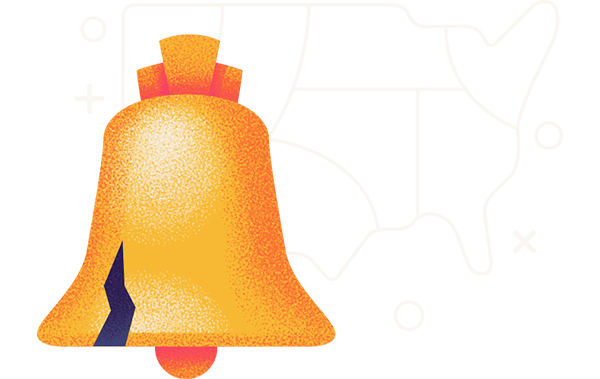Americans value independence. We fought hard for it during the American Revolutionary War, and in the present day, we celebrate not only our freedom from the British crown but also our strong ability to rely upon ourselves as individuals. Now, with sky-high inflation affecting people across the country, many Americans are struggling to maintain financial independence. Some have become at least temporarily more dependent on support from the federal government. Other people have become more dependent on personal vices, such as drinking and drugs, due to stress and depression.
In order to find out where Americans are the most self-reliant, WalletHub compared the 50 states based on five sources of dependency: consumer finances, the government, the job market, international trade and personal vices. We broke down these categories into 39 key indicators of independence in order to determine which states are most self-sustaining.
Top 5 Most Independent States
- Utah
- Colorado
- Virginia
- Idaho
- Hawaii

Chip Lupo, WalletHub Analyst
Main Findings
Most Independent States
| Overall Rank | State | Total Score | Financial Dependency Rank | Government Dependency Rank | Job-Market Dependency Rank | International-Trade Dependency Rank | Vice Dependency Rank |
|---|---|---|---|---|---|---|---|
| 1 | Utah | 64.71 | 25 | 3 | 5 | 12 | 1 |
| 2 | Colorado | 61.39 | 5 | 8 | 42 | 4 | 21 |
| 3 | Virginia | 61.14 | 7 | 20 | 11 | 10 | 5 |
| 4 | Idaho | 60.51 | 34 | 17 | 12 | 2 | 15 |
| 5 | Hawaii | 59.19 | 12 | 33 | 15 | 5 | 4 |
| 6 | Massachusetts | 58.93 | 2 | 12 | 18 | 29 | 12 |
| 7 | Washington | 58.41 | 6 | 13 | 32 | 23 | 8 |
| 8 | California | 58.27 | 13 | 7 | 46 | 20 | 7 |
| 9 | Wisconsin | 57.78 | 14 | 15 | 4 | 24 | 22 |
| 10 | Montana | 57.60 | 22 | 30 | 23 | 1 | 37 |
| 11 | Connecticut | 57.03 | 11 | 16 | 35 | 27 | 3 |
| 12 | Vermont | 56.90 | 10 | 38 | 7 | 11 | 9 |
| 13 | Minnesota | 56.47 | 1 | 27 | 8 | 28 | 26 |
| 14 | Florida | 56.34 | 21 | 21 | 36 | 15 | 16 |
| 15 | South Dakota | 56.09 | 26 | 32 | 1 | 16 | 28 |
| 16 | New Jersey | 55.95 | 9 | 6 | 49 | 32 | 6 |
| 17 | Nebraska | 55.93 | 33 | 11 | 3 | 26 | 39 |
| 18 | Delaware | 55.67 | 23 | 1 | 38 | 40 | 11 |
| 19 | New York | 55.29 | 4 | 29 | 39 | 25 | 2 |
| 20 | Iowa | 55.24 | 28 | 5 | 6 | 38 | 30 |
| 21 | North Dakota | 55.09 | 16 | 19 | 2 | 42 | 17 |
| 22 | Kansas | 55.08 | 32 | 2 | 22 | 30 | 44 |
| 23 | Maryland | 54.59 | 8 | 45 | 28 | 7 | 10 |
| 24 | New Hampshire | 54.40 | 3 | 26 | 14 | 37 | 18 |
| 25 | Georgia | 53.26 | 41 | 4 | 27 | 31 | 34 |
| 26 | North Carolina | 52.81 | 35 | 14 | 33 | 33 | 19 |
| 27 | Pennsylvania | 52.75 | 20 | 31 | 29 | 22 | 20 |
| 28 | Nevada | 51.99 | 42 | 18 | 40 | 9 | 43 |
| 29 | Missouri | 51.81 | 39 | 24 | 13 | 17 | 45 |
| 30 | Maine | 51.74 | 27 | 39 | 20 | 13 | 36 |
| 31 | Arizona | 51.26 | 36 | 40 | 19 | 18 | 14 |
| 32 | Rhode Island | 50.78 | 18 | 41 | 44 | 19 | 13 |
| 33 | Illinois | 50.56 | 29 | 10 | 43 | 43 | 23 |
| 34 | Ohio | 50.38 | 31 | 22 | 30 | 36 | 42 |
| 35 | Wyoming | 50.33 | 30 | 43 | 34 | 8 | 38 |
| 36 | Arkansas | 49.07 | 48 | 23 | 9 | 14 | 48 |
| 37 | Oregon | 48.98 | 24 | 36 | 31 | 34 | 29 |
| 38 | Oklahoma | 48.80 | 47 | 34 | 25 | 3 | 49 |
| 39 | Texas | 48.46 | 17 | 9 | 17 | 49 | 27 |
| 40 | Tennessee | 47.25 | 38 | 25 | 10 | 41 | 46 |
| 41 | Michigan | 46.86 | 19 | 28 | 37 | 44 | 32 |
| 42 | New Mexico | 44.56 | 46 | 48 | 50 | 6 | 31 |
| 43 | Alabama | 43.43 | 43 | 37 | 24 | 39 | 41 |
| 44 | Indiana | 43.09 | 37 | 35 | 21 | 46 | 33 |
| 45 | South Carolina | 40.89 | 40 | 42 | 26 | 47 | 24 |
| 46 | Alaska | 40.26 | 15 | 50 | 41 | 45 | 25 |
| 47 | West Virginia | 40.22 | 45 | 49 | 48 | 21 | 35 |
| 48 | Mississippi | 37.86 | 50 | 47 | 16 | 35 | 50 |
| 49 | Kentucky | 33.15 | 44 | 46 | 45 | 50 | 40 |
| 50 | Louisiana | 32.06 | 49 | 44 | 47 | 48 | 47 |
Note: With the exception of “Total Score,” all of the columns in the table above depict the relative rank of that state, where a rank of 1 represents the best conditions for that metric category.

- Highest
- 1. Minnesota
- 2. New Hampshire
- T-3. Vermont
- T-3. Wisconsin
- T-5. Massachusetts
- T-5. Washington

- Lowest
- 46. Oklahoma
- 47. Texas
- 48. Alabama
- 49. Louisiana
- 50. Mississippi

- Highest %
- 1. Hawaii
- 2. Delaware
- 3. Connecticut
- 4. Massachusetts
- 5. Rhode Island

- Lowest %
- 46. Tennessee
- T-47. Arkansas
- T-47. Oklahoma
- 49. Mississippi
- 50. West Virginia

- Highest
- 1. Iowa
- 2. Idaho
- 3. Oregon
- 4. Montana
- 5. Hawaii

- Lowest
- 46. California
- 47. Texas
- 48. Rhode Island
- 49. Georgia
- 50. Florida

(Adjusted by Cost of Living)
- Highest
- 1. Virginia
- 2. Utah
- 3. Minnesota
- 4. New Jersey
- 5. Colorado

- Lowest
- 46. Mississippi
- 47. New Mexico
- 48. Louisiana
- 49. Maine
- 50. West Virginia

- Least
- 1. New Jersey
- 2. California
- 3. Delaware
- 4. Massachusetts
- 5. Utah

- Most
- 46. South Carolina
- 47. Mississippi
- 48. West Virginia
- 49. Kentucky
- 50. Alaska

- Lowest %
- 1. Wyoming
- 2. Utah
- 3. Kansas
- 4. North Dakota
- 5. South Carolina

- Highest %
- 46. West Virginia
- 47. Rhode Island
- 48. New York
- 49. Oregon
- 50. New Mexico

- Lowest
- T-1. South Dakota
- T-1. Hawaii
- T-1. Vermont
- T-1. Maryland
- T-5. North Dakota
- T-5. Virginia

- Highest
- T-45. Alaska
- T-45. Rhode Island
- T-47. California
- T-47. Kentucky
- T-49. Michigan
- T-49. Nevada

- Lowest %
- 1. Hawaii
- 2. Colorado
- 3. Oklahoma
- 4. New Mexico
- 5. Rhode Island

- Highest %
- 46. Iowa
- 47. North Dakota
- T-48. Alaska
- T-48. Texas
- T-48. Louisiana

- Lowest %
- 1. Hawaii
- 2. Colorado
- 3. Virginia
- 4. Oklahoma
- 5. South Dakota

- Highest %
- 46. South Carolina
- 47. Indiana
- T-48. Kentucky
- T-48. Texas
- T-48. Louisiana

- Lowest %
- 1. Utah
- 2. Texas
- 3. Wyoming
- 4. Iowa
- 5. Alabama

- Highest %
- 46. Alaska
- 47. Oregon
- 48. Maine
- 49. New Mexico
- 50. Vermont

- Lowest %
- 1. Michigan
- T-2. Connecticut
- T-2. Florida
- T-2. Kentucky
- T-5. Indiana
- T-5. Iowa

- Highest %
- 46. Nevada
- T-47. Kansas
- T-47. New Jersey
- 49. Minnesota
- 50. Mississippi

- Lowest %
- 1. Utah
- T-2. Maryland
- T-2. New Mexico
- T-4. Kentucky
- T-4. Virginia

- Highest %
- 46. Nebraska
- 47. South Dakota
- 48. Montana
- 49. North Dakota
- 50. Iowa
In-Depth Look at the Most Independent States
Utah
Utah is the most independent state in America, in part because very few people receive government benefits. Utah has an extremely low percentage of people with public assistance income (1.6%) or who receive SNAP or food stamps (5.3%). The state ranks as one of the least dependent on federal funding, as well.
In addition, Utah residents don’t rely on unemployment income, as the state has a 3.2% unemployment rate, one of the lowest in the country. It also has the second-highest median income in the country (over $88,500) and the second-lowest share of people in poverty.
To top things off, people in Utah are not very dependent on addictive substances. Utah has the lowest share of people who smoke or binge drink in the country.
Colorado
Colorado is the second-most independent state, with one reason being that its economy doesn’t have to rely on exports to foreign countries. Colorado has a very low percentage of jobs that are supported by exported goods, and exports to other countries make up a very low portion of its GDP.
Colorado’s population is good at money management, too, with only around 16% of people spending more than they make, the second-lowest percentage in the country. This allows people to be less susceptible to high interest rates and better able to save.
The ability to save money is also preparing Colorado residents well for their future. Colorado has the ninth-highest share of people who are setting aside money for their children’s college, and the seventh-highest share of people who saved for emergencies in the past 12 months.
Virginia
Virginia is the third-most independent state. Its residents show their independence from common addictions. Virginia has the third-lowest share of binge drinking among adults, as well as relatively low number of opioid prescriptions dispensed and low rates of smoking. Virginia residents also have some of the lowest usage of online social networks.
Finally, Virginia residents are doing pretty well financially. The unemployment rate is just 3.1%, and the state has the highest median income in the country. In addition, only 9.9% of people are living in poverty, the seventh-lowest rate nationally.
Ask the Experts
Reliance on others can be challenging to overcome. For the best ways to achieve greater independence in several of the dependency categories we examined in this report, we asked a panel of experts to share their thoughts on the following key questions:
- Is it fair that some states are more dependent on the Federal Government than others?
- What tips do you have for a person who wishes to increase their financial independence? What are some first steps?
- What tips do you have for a person who wishes to reduce his/her job dependency? Should they try to join the “gig” economy?
- With only 45% of young adults being financially independent, what are some of the best ways parents can prepare their children to be financially independent in their adult life?
- Should presidential campaigns be publicly funded in order to help ensure the President is as independent as possible from special interests?
- Should states try to make their economies more or less dependent on international trade? How?
Ask the Experts
Director, MA in Public Management - Johns Hopkins University
Read More
Assistant Professor, Political Science - The University of Alabama
Read More
Associate Professor, Family & Community Development Agent – West Virginia University
Read More
Ph.D. – Professor, Department of Political Science – University of Louisville
Read More
Ph.D., J.D. – Professor and Director of the Reiman School of Finance in the Daniels College of Business – University of Denver
Read More
Ph.D. – Professor Emeritus, Department of Political Science – Saint Louis University
Read More
Methodology
In order to determine the most independent states, WalletHub compared the 50 states across five key dimensions: 1) Financial Dependency, 2) Government Dependency, 3) Job-Market Dependency, 4) International-Trade Dependency and 5) Vice Dependency.
We evaluated those dimensions using 39 relevant metrics, which are listed below with their corresponding weights. Each metric was graded on a 100-point scale, with a score of 100 representing the highest level of independence.
We then determined each state’s weighted average across all metrics to calculate its overall score and used the resulting scores to rank-order the states.
Financial Dependency – Total Points: 20
- Median Credit Score: Full Weight (~1.18 Points)
- Share of Adults with Rainy-Day & Emergency Funds: Full Weight (~1.18 Points)
Note: This metric is based on the Federal Deposit Insurance Corporation’s economic inclusion survey and measures the share of adults who have set aside emergency or rainy day funds that would cover expenses for 3 months, in case of sickness, job loss, economic downturn, or other emergencies. - Share of Adults Saving for Children’s College Education: Double Weight (~2.35 Points)
Note: “Adults” include individuals with financially dependent children. - Employer-Based Retirement Access & Participation: Full Weight (~1.18 Points)
- Median Debt per Income: Double Weight (~2.35 Points)
- Median Household Income (Adjusted by Cost of Living Index): Full Weight (~1.18 Points)
- Poverty Rate: Full Weight (~1.18 Points)
- Age Dependency Ratio: Full Weight (~1.18 Points)
Note: Age dependency ratio is the ratio of dependents--people younger than 15 or older than 64 – to the working-age population – those ages 15-64. - Share of Millennials Living with Their Parents: Full Weight (~1.18 Points)
- Share of Low-Income Households where No Adults Work: Full Weight (~1.18 Points)
- Share of Seriously Underwater Mortgages: Double Weight (~2.35 Points)
Note: This metric measures the share of homes with mortgages that have a combined estimated balance of loans secured by the property at least 25 percent more than the property's estimated market value. - Homeownership Rate: Full Weight (~1.18 Points)
- Foreclosure Rate: Full Weight (~1.18 Points)
- Bankruptcy Rate: Full Weight (~1.18 Points)
Government Dependency – Total Points: 20
- Federal Dependence: Quadruple Weight (~10.00 Points)
Note: This metric is based on WalletHub’s “Most & Least Federally Dependent States” ranking. - Share of Household Receiving Public Assistance & SNAP/Food Stamps: Full Weight (~2.50 Points)
Note: “SNAP” refers to the national Supplemental Nutrition Assistance Program. - Share of Occupied Subsidized Housing Units: Full Weight (~2.50 Points)
- Share of Federal-, State- & Local-Government Employees: Full Weight (~2.50 Points)
- Tax Freedom Day: Full Weight (~2.50 Points)
Note: “Tax Freedom Day” refers to the day when the state’s taxpayers have collectively earned enough money to pay their federal, state and local tax bills for the year. This metric measures the number of days since the beginning of the year that the event takes place (sooner indicates greater independence).
Job-Market Dependency – Total Points: 20
- Industry Variety: Full Weight (~3.33 Points)
- Job Growth Rate: Full Weight (~3.33 Points)
- Unemployment Rate: Full Weight (~3.33 Points)
- Long-Term Unemployment Rate: Full Weight (~3.33 Points)
Note: This metric measures the share of the unemployed who had been jobless for 27 weeks or longer. - Underemployment Rate: Full Weight (~3.33 Points)
- Job Creation Index: Full Weight (~3.33 Points)
Note: This metric is based on Gallup’s “Job Creation Index” and measures the share of workers who reported that their employer is increasing its workforce minus the percentage reporting the opposite.
International-Trade Dependency – Total Points: 20
- Share of Jobs Supported by Exported Goods: Full Weight (~6.67 Points)
- Share of Private-Industry Employment at Foreign-Owned Firms: Full Weight (~6.67 Points)
- Share of State GDP Generated by Exports to Other Countries: Full Weight (~6.67 Points)
Vice Dependency – Total Points: 20
- Share of Adult Drug Users: Full Weight (~1.67 Points)
Note: “Drug Users” refer to individuals who reported using illicit drugs in the past month. - Retail Opioid Prescriptions Dispensed per 100 Persons: Full Weight (~1.67 Points)
- Share of Adult Binge Drinkers: Full Weight (~1.67 Points)
- Share of Current Adult Smokers: Double Weight (~3.33 Points)
- Share of Adults with Gambling Disorders: Full Weight (~1.67 Points)
- Share of Population Spending More than They Earn: Full Weight (~1.67 Points)
- Share of Social-Network Users: Full Weight (~1.67 Points)
Note: “Users” refer to the population aged 15 and older. - Share of Online-Video Watchers: Full Weight (~1.67 Points)
Note: “Watchers” refer to the population aged 15 and older. - Share of Smart-Device Users: Full Weight (~1.67 Points)
Note: “Users” refer to the population aged 3 and older. - Median Daily Time Spent Watching TV: Full Weight (~1.67 Points)
- Average Time Spent on Adult Entertainment Sites: Full Weight (~1.67 Points)
Sources: Data used to create this ranking were collected as of April 17, 2025 from U.S. Census Bureau, Bureau of Labor Statistics, FINRA Investor Education Foundation, Economic Innovation Group, Council for Community and Economic Research, Tax Foundation, Gallup, International Trade Administration, U.S. Bureau of Economic Analysis, Substance Abuse and Mental Health Services Administration, Centers for Disease Control and Prevention, National Council on Problem Gambling, National Telecommunications and Information Administration, Minnesota Population Center, University of Minnesota, TransUnion, Administrative Office of the U.S. Courts, U.S. Department of Housing and Urban Development, ATTOM, a property data provider - U.S. Home Equity & Underwater Report, ATTOM, a property data provider - U.S. Foreclosure Market Report, PornHub and WalletHub research.








WalletHub experts are widely quoted. Contact our media team to schedule an interview.